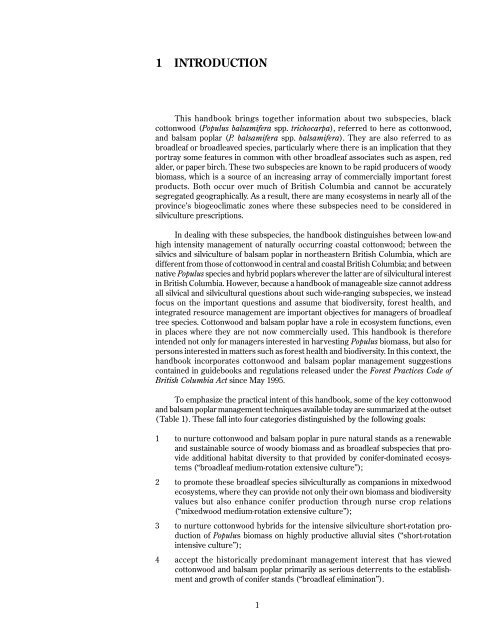FRDA Report: Black Cottonwood and Balsam Poplar Managers ...
FRDA Report: Black Cottonwood and Balsam Poplar Managers ...
FRDA Report: Black Cottonwood and Balsam Poplar Managers ...
Create successful ePaper yourself
Turn your PDF publications into a flip-book with our unique Google optimized e-Paper software.
1 INTRODUCTION<br />
This h<strong>and</strong>book brings together information about two subspecies, black<br />
cottonwood (Populus balsamifera spp. trichocarpa), referred to here as cottonwood,<br />
<strong>and</strong> balsam poplar (P. balsamifera spp. balsamifera). They are also referred to as<br />
broadleaf or broadleaved species, particularly where there is an implication that they<br />
portray some features in common with other broadleaf associates such as aspen, red<br />
alder, or paper birch. These two subspecies are known to be rapid producers of woody<br />
biomass, which is a source of an increasing array of commercially important forest<br />
products. Both occur over much of British Columbia <strong>and</strong> cannot be accurately<br />
segregated geographically. As a result, there are many ecosystems in nearly all of the<br />
province’s biogeoclimatic zones where these subspecies need to be considered in<br />
silviculture prescriptions.<br />
In dealing with these subspecies, the h<strong>and</strong>book distinguishes between low-<strong>and</strong><br />
high intensity management of naturally occurring coastal cottonwood; between the<br />
silvics <strong>and</strong> silviculture of balsam poplar in northeastern British Columbia, which are<br />
different from those of cottonwood in central <strong>and</strong> coastal British Columbia; <strong>and</strong> between<br />
native Populus species <strong>and</strong> hybrid poplars wherever the latter are of silvicultural interest<br />
in British Columbia. However, because a h<strong>and</strong>book of manageable size cannot address<br />
all silvical <strong>and</strong> silvicultural questions about such wide-ranging subspecies, we instead<br />
focus on the important questions <strong>and</strong> assume that biodiversity, forest health, <strong>and</strong><br />
integrated resource management are important objectives for managers of broadleaf<br />
tree species. <strong>Cottonwood</strong> <strong>and</strong> balsam poplar have a role in ecosystem functions, even<br />
in places where they are not now commercially used. This h<strong>and</strong>book is therefore<br />
intended not only for managers interested in harvesting Populus biomass, but also for<br />
persons interested in matters such as forest health <strong>and</strong> biodiversity. In this context, the<br />
h<strong>and</strong>book incorporates cottonwood <strong>and</strong> balsam poplar management suggestions<br />
contained in guidebooks <strong>and</strong> regulations released under the Forest Practices Code of<br />
British Columbia Act since May 1995.<br />
To emphasize the practical intent of this h<strong>and</strong>book, some of the key cottonwood<br />
<strong>and</strong> balsam poplar management techniques available today are summarized at the outset<br />
( Table 1). These fall into four categories distinguished by the following goals:<br />
1 to nurture cottonwood <strong>and</strong> balsam poplar in pure natural st<strong>and</strong>s as a renewable<br />
<strong>and</strong> sustainable source of woody biomass <strong>and</strong> as broadleaf subspecies that provide<br />
additional habitat diversity to that provided by conifer-dominated ecosystems<br />
(“broadleaf medium-rotation extensive culture”);<br />
2 to promote these broadleaf species silviculturally as companions in mixedwood<br />
ecosystems, where they can provide not only their own biomass <strong>and</strong> biodiversity<br />
values but also enhance conifer production through nurse crop relations<br />
(“mixedwood medium-rotation extensive culture”);<br />
3 to nurture cottonwood hybrids for the intensive silviculture short-rotation production<br />
of Populus biomass on highly productive alluvial sites (“short-rotation<br />
intensive culture”);<br />
4 accept the historically predominant management interest that has viewed<br />
cottonwood <strong>and</strong> balsam poplar primarily as serious deterrents to the establishment<br />
<strong>and</strong> growth of conifer st<strong>and</strong>s (“broadleaf elimination”).<br />
1

















